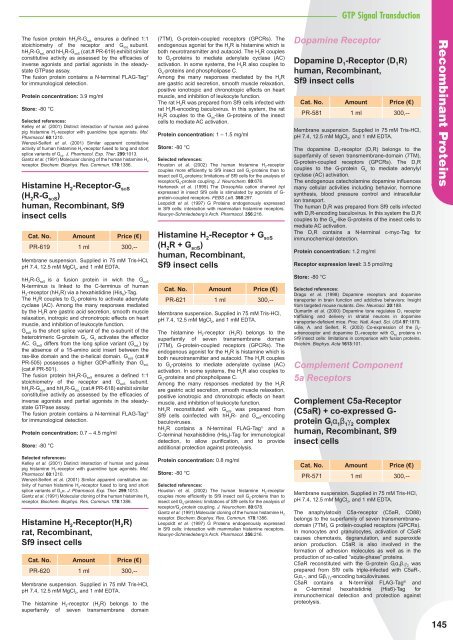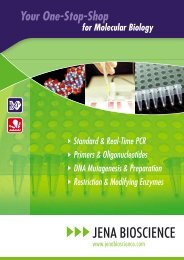Nucleotide Analogs - Jena Bioscience
Nucleotide Analogs - Jena Bioscience
Nucleotide Analogs - Jena Bioscience
You also want an ePaper? Increase the reach of your titles
YUMPU automatically turns print PDFs into web optimized ePapers that Google loves.
The fusion protein hH 2 R-G sαL ensures a defi ned 1:1<br />
stoichiometry of the receptor and G sαL subunit.<br />
hH 2 R-G sαL and hH 2 R-G sαS (cat.# PR-619) exhibit similar<br />
constitutive activity as assessed by the effi cacies of<br />
inverse agonists and partial agonists in the steadystate<br />
GTPase assay.<br />
The fusion protein contains a N-terminal FLAG-Tag ®<br />
for immunological detection.<br />
Protein concentration: 3.9 mg/ml<br />
Store: -80 °C<br />
Selected references:<br />
Kelley et al. (2001) Distinct interaction of human and guinea<br />
pig histamine H 2 -receptor with guanidine type agonists. Mol.<br />
Pharmacol. 60:1210.<br />
Wenzel-Seifert et al. (2001) Similar apparent constitutive<br />
activity of human histamine H 2 -receptor fused to long and short<br />
splice variants of G sα . J. Pharmacol. Exp. Ther. 299:1013.<br />
Gantz et al. (1991) Molecular cloning of the human histamine H 2<br />
receptor. Biochem. Biophys. Res. Commun. 178:1386.<br />
Histamine H 2 -Receptor-G sαS<br />
(H 2 R-G sαS )<br />
human, Recombinant, Sf9<br />
insect cells<br />
Cat. No. Amount Price (€)<br />
PR-619 1 ml 300,--<br />
Membrane suspension. Supplied in 75 mM Tris-HCl,<br />
pH 7.4, 12.5 mM MgCl 2, and 1 mM EDTA.<br />
hH 2 R-G sαS is a fusion protein in wich the G sαS<br />
N-terminus is linked to the C-terminus of human<br />
H 2-receptor (hH 2R) via a hexahistidine (His 6)-Tag.<br />
The H 2R couples to G s-proteins to activate adenylate<br />
cyclase (AC). Among the many responses mediated<br />
by the H 2 R are gastric acid secretion, smooth muscle<br />
relaxation, inotropic and chronotropic effects on heart<br />
muscle, and inhibition of leukocyte function.<br />
G sαS is the short splice variant of the α-subunit of the<br />
heterotrimeric G-protein G s. G s activates the effector<br />
AC. G sαS differs from the long splice variant (G sαL ) by<br />
the absence of a 15-amino acid insert between the<br />
ras-like domain and the α-helical domain. G sαS (cat.#<br />
PR-505) possesses a higher GDP-affi nity than G sαL<br />
(cat.# PR-501).<br />
The fusion protein hH 2 R-G sαS ensures a defi ned 1:1<br />
stoichiometry of the receptor and G sαS subunit.<br />
hH 2R-G sαS and hH 2R-G sαL (cat.# PR-618) exhibit similar<br />
constitutive activity as assessed by the effi cacies of<br />
inverse agonists and partial agonists in the steadystate<br />
GTPase assay.<br />
The fusion protein contains a N-terminal FLAG-Tag ®<br />
for immunological detection.<br />
Protein concentration: 0.7 – 4.5 mg/ml<br />
Store: -80 °C<br />
Selected references:<br />
Kelley et al. (2001) Distinct interaction of human and guinea<br />
pig histamine H 2 -receptor with guanidine type agonists. Mol.<br />
Pharmacol. 60:1210.<br />
Wenzel-Seifert et al. (2001) Similar apparent constitutive activity<br />
of human histamine H 2 -receptor fused to long and short<br />
splice variants of G s α. J. Pharmacol. Exp. Ther. 299:1013.<br />
Gantz et al. (1991) Molecular cloning of the human histamine H 2<br />
receptor. Biochem. Biophys. Res. Commun. 178:1386.<br />
Histamine H 2 -Receptor(H 2 R)<br />
rat, Recombinant,<br />
Sf9 insect cells<br />
Cat. No. Amount Price (€)<br />
PR-620 1 ml 300,--<br />
Membrane suspension. Supplied in 75 mM Tris-HCl,<br />
pH 7.4, 12.5 mM MgCl 2, and 1 mM EDTA.<br />
The histamine H 2 -receptor (H 2 R) belongs to the<br />
superfamily of seven transmembrane domain<br />
(7TM), G-protein-coupled receptors (GPCRs). The<br />
endogenous agonist for the H 2 R is histamine which is<br />
both neurotransmitter and autacoid. The H 2 R couples<br />
to G s -proteins to mediate adenylate cyclase (AC)<br />
activation. In some systems, the H 2 R also couples to<br />
G q -proteins and phospholipase C.<br />
Among the many responses mediated by the H 2 R<br />
are gastric acid secretion, smooth muscle relaxation,<br />
positive ionotropic and chronotropic effects on heart<br />
muscle, and inhibition of leukocyte function.<br />
The rat H 2 R was prepared from Sf9 cells infected with<br />
rat H 2R-encoding baculovirus. In this system, the rat<br />
H 2 R couples to the G sα -like G-proteins of the insect<br />
cells to mediate AC activation.<br />
Protein concentration: 1 – 1.5 mg/ml<br />
Store: -80 °C<br />
Selected references:<br />
Houston et al. (2002) The human histamine H 2 -receptor<br />
couples more effi ciently to Sf9 insect cell G s -proteins than to<br />
insect cell G q -proteins: limitations of Sf9 cells for the analysis of<br />
receptor/G q -protein coupling. J. Neurochem. 80:678.<br />
Harteneck et al. (1995) The Drosophila cation channel trpl<br />
expressed in insect Sf9 cells is stimulated by agonists of Gprotein-coupled<br />
receptors. FEBS Lett. 358:297.<br />
Leopoldt et al. (1997) G Proteins endogenously expressed<br />
in Sf9 cells: interaction with mammalian histamine receptors.<br />
Naunyn-Schmiedeberg’s Arch. Pharmacol. 356:216.<br />
Histamine H 2 -Receptor + G sαS<br />
(H 2 R + G sαS )<br />
human, Recombinant,<br />
Sf9 insect cells<br />
Cat. No. Amount Price (€)<br />
PR-621 1 ml 300,--<br />
Membrane suspension. Supplied in 75 mM Tris-HCl,<br />
pH 7.4, 12.5 mM MgCl 2, and 1 mM EDTA.<br />
The histamine H 2-receptor (H 2R) belongs to the<br />
superfamily of seven transmembrane domain<br />
(7TM), G-protein-coupled receptors (GPCRs). The<br />
endogenous agonist for the H 2R is histamine which is<br />
both neurotransmitter and autacoid. The H 2R couples<br />
to G s-proteins to mediate adenylate cyclase (AC)<br />
activation. In some systems, the H 2 R also couples to<br />
G q -proteins and phospholipase C.<br />
Among the many responses mediated by the H 2R<br />
are gastric acid secretion, smooth muscle relaxation,<br />
positive ionotropic and chronotropic effects on heart<br />
muscle, and inhibition of leukocyte function.<br />
hH 2R reconstituted with G sαS was prepared from<br />
Sf9 cells coinfected with hH 2R- and G sαS-encoding<br />
baculoviruses.<br />
hH 2R contains a N-terminal FLAG-Tag ® and a<br />
C-terminal hexahistidine (His 6 )-Tag for immunological<br />
detection, to allow purifi cation, and to provide<br />
additional protection against proteolysis.<br />
Protein concentration: 0.8 mg/ml<br />
Store: -80 °C<br />
Selected references:<br />
Houston et al. (2002) The human histamine H 2 -receptor<br />
couples more effi ciently to Sf9 insect cell G s -proteins than to<br />
insect cell G q -proteins: limitations of Sf9 cells for the analysis of<br />
receptor/G q -protein coupling. J. Neurochem. 80:678.<br />
Gantz et al. (1991) Molecular cloning of the human histamine H 2<br />
receptor. Biochem. Biophys. Res. Commun. 178:1386.<br />
Leopoldt et al. (1997) G Proteins endogenously expressed<br />
in Sf9 cells: interaction with mammalian histamine receptors.<br />
Naunyn-Schmiedeberg’s Arch. Pharmacol. 356:216.<br />
Dopamine Receptor<br />
GTP Signal Transduction<br />
Dopamine D 1 -Receptor (D 1 R)<br />
human, Recombinant,<br />
Sf9 insect cells<br />
Cat. No. Amount Price (€)<br />
PR-581 1 ml 300,--<br />
Membrane suspension. Supplied in 75 mM Tris-HCl,<br />
pH 7.4, 12.5 mM MgCl 2 , and 1 mM EDTA.<br />
The dopamine D 1 -receptor (D 1 R) belongs to the<br />
superfamily of seven transmembrane-domain (7TM),<br />
G-protein-coupled receptors (GPCRs). The D 1R<br />
couples to the G-protein G s to mediate adenylyl<br />
cyclase (AC) activation.<br />
The endogenous catecholamine dopamine infl uences<br />
many cellular activities including behavior, hormone<br />
synthesis, blood pressure control and intracellular<br />
ion transport.<br />
The human D 1 R was prepared from Sf9 cells infected<br />
with D 1 R-encoding baculovirus. In this system the D 1 R<br />
couples to the G sα -like G-proteins of the insect cells to<br />
mediate AC activation.<br />
The D 1 R contains a N-terminal c-myc-Tag for<br />
immunochemical detection.<br />
Protein concentration: 1.2 mg/ml<br />
Receptor expression level: 3.5 pmol/mg<br />
Store: -80 °C<br />
Selected references:<br />
Drago et al. (1998) Dopamine receptors and dopamine<br />
transporter in brain function and addictive behaviors: Insight<br />
from targeted mouse mutants. Dev. Neurosci. 20:188.<br />
Dumartin et al. (2000) Dopamine tone regulates D 1 receptor<br />
traffi cking and delivery in striatal neurons in dopamine<br />
transporter-defi cient mice. Proc. Natl. Acad. Sci. USA 97:1879.<br />
Gille, A. and Seifert, R. (2003) Co-expression of the β 2 -<br />
adrenoceptor and dopamine D 1 -receptor with G sα proteins in<br />
Sf9 insect cells: limitations in comparison with fusion proteins.<br />
Biochim. Biophys. Acta 1613:101.<br />
Complement Component<br />
5a Receptors<br />
Complement C5a-Receptor<br />
(C5aR) + co-expressed Gprotein<br />
G i α 1 β 1 γ 2 complex<br />
human, Recombinant, Sf9<br />
insect cells<br />
Cat. No. Amount Price (€)<br />
PR-571 1 ml 300,--<br />
Membrane suspension. Supplied in 75 mM Tris-HCl,<br />
pH 7.4, 12.5 mM MgCl 2 , and 1 mM EDTA.<br />
The anaphylatoxin C5a-receptor (C5aR, CD88)<br />
belongs to the superfamily of seven transmembranedomain<br />
(7TM), G protein-coupled receptors (GPCRs).<br />
In monocytes and granulocytes, activation of C5aR<br />
causes chemotaxis, degranulation, and superoxide<br />
anion production. C5aR is also involved in the<br />
formation of adhesion molecules as well as in the<br />
production of so-called “acute-phase” proteins.<br />
C5aR reconstituted with the G-protein G i α 1 β 1 γ 2 was<br />
prepared from Sf9 cells triple-infected with C5aR-,<br />
G i α 1 -, and Gβ 1 γ 2 -encoding baculoviruses.<br />
C5aR contains a N-terminal FLAG-Tag ® and<br />
a C-terminal hexahistidine (His6)-Tag for<br />
immunochemical detection and protection against<br />
proteolysis.<br />
Recombinant Proteins<br />
145



